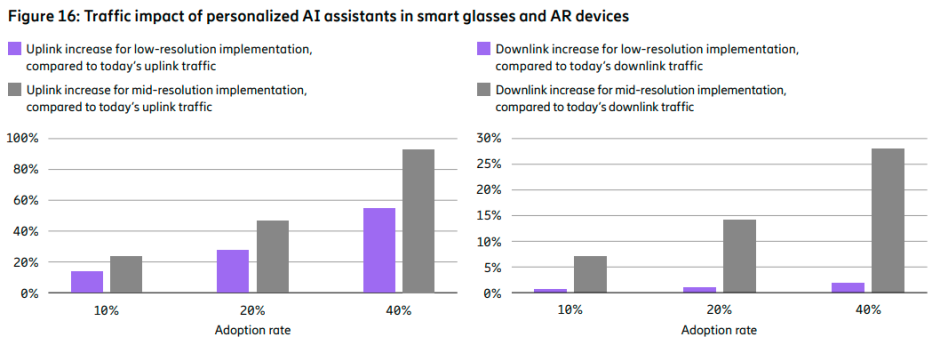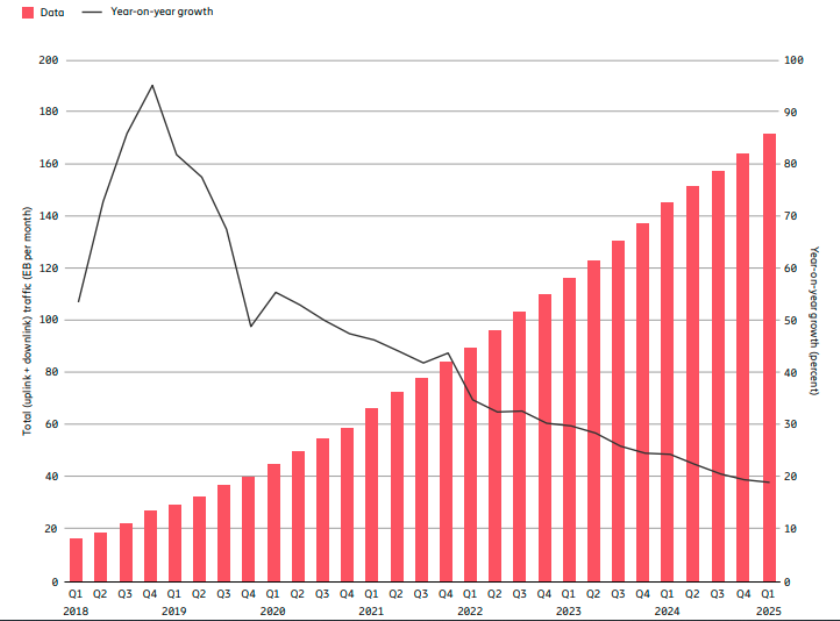Generative AI (GenAI) is beginning to shape mobile network data patterns, though its current overall traffic footprint remains relatively modest.

According to the June 2025 Ericsson Mobility Report, global mobile data traffic (excluding Fixed Wireless Access) is projected to grow 2.3 times, reaching 280 exabytes (EB) per month by 2030. Including FWA, total mobile network traffic is expected to grow 2.6 times to 430 EB per month. This represents a slight downward revision from earlier forecasts due to updated data from key markets. The share of 5G in mobile data traffic rose from 26 percent in 2023 to 35 percent by end-2024, and is expected to reach 80 percent by 2030.

GenAI traffic accounts for just 0.06 percent of total mobile network data usage globally. However, the nature of this traffic is already diverging sharply from typical mobile app behavior, especially in uplink distribution.
While most mobile network traffic follows a 90:10 downlink-to-uplink ratio, GenAI-related usage shows a much higher uplink share — 26 percent, indicating the interactive and content-generation-heavy nature of these applications.
The mobile AI app ecosystem is growing rapidly, with 115 million downloads in December 2024 alone—a year-on-year growth of 81 percent. Over 29,000 AI apps are now available across platforms, with nearly half of them launched in 2024. These apps are primarily used on high-end smartphones, underlining their bandwidth and processing demands.
ChatGPT dominates the GenAI app ecosystem, with 250 million installs and 546 million monthly active users as of April 2025. It contributes 60 percent of GenAI traffic and 70 percent of uplink traffic, with a 71:29 downlink/uplink distribution. Other text-based GenAI tools like DeepSeek and Microsoft Copilot show an even split between uplink and downlink, highlighting more balanced interaction models.
Visual and video-based GenAI apps drive significantly higher per-user data consumption. Invideo AI, focused on video creation, leads with 504 MB per user per month, despite its smaller user base. Other content-generation apps like Canva AI and Adobe Firefly average around 200 MB per user monthly. By contrast, Gemini AI, the most widely used GenAI app by user count due to pre-installation on Android devices, shows modest average usage — around 2 MB monthly — with peak users reaching just 10 GB.
Looking ahead, GenAI’s influence on network infrastructure is expected to grow significantly. The evolution from chat-based apps to GenAI-powered smartphones, extended reality (XR) devices, and rich media formats will drive higher traffic volumes, especially in uplink data. This shift will likely compel operators to reassess network capacity planning, quality of service, and pricing models to accommodate the next wave of GenAI-enabled mobile experiences.
The rapid rise of AI agents and AI-native applications is being fueled by the convergence of advanced networks, smarter devices, and immersive content. Modern 5G networks are evolving to support capabilities like low latency, high uplink speeds, and edge access, while APIs now allow developers to harness these network features. At the same time, devices such as smartphones and AR glasses are transforming into AI-powered, multimodal platforms with improved sensors and AI accelerators.
GenAI is driving hyper-personalized user experiences, from smarter content creation on smartphones to immersive AR applications that rely on cloud processing. This surge in AI-native, data-intensive use cases is expected to significantly increase uplink-heavy mobile traffic, demanding careful network planning and additional spectrum resources.
A new generation of personalized AI agents is emerging, acting as intelligent assistants across smartphones, wearables, and even robotic companions. These agents deliver real-time, context-aware services such as scheduling, translation, and adaptive learning, redefining human-machine interaction and marking a foundational shift toward AI-native ecosystems that rely on high-performance connectivity.
Meanwhile, Globe Telecom has highlighted the transformative role of AI in broadband operations and customer experience. Globe’s Chief Commercial Officer Darius Delgado, at the World Broadband Association (WBBA) Broadband Development Conference 2025 in Shanghai, shared how the company uses AI across the broadband value chain — from infrastructure planning to in-home optimization.
Darius Delgado said AI enables faster expansion decisions, improves fault detection by 90 percent, and reduces service restoration time by 70 percent. It also powers automated band steering to deliver optimal speeds within homes.
Significant impact on networks will come from AI applications that are both data-intensive and widely adopted. A key example is video-based AI assistants, which rely on real-time video feeds for interaction. These applications require continuous uplink and downlink traffic and advanced semantic processing, which typically exceeds the capabilities of on-device GenAI models, leading to increased demand on network infrastructure, Ericsson Mobility Report said.
TelecomLead.com News Desk
